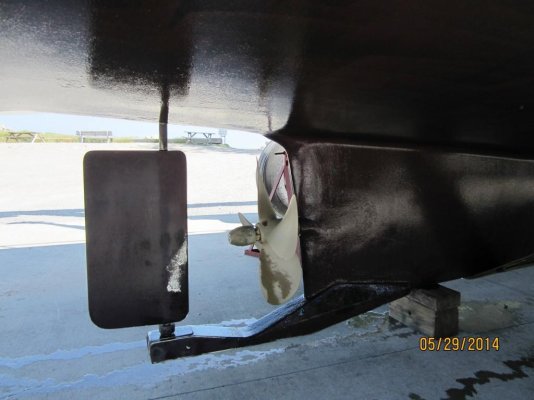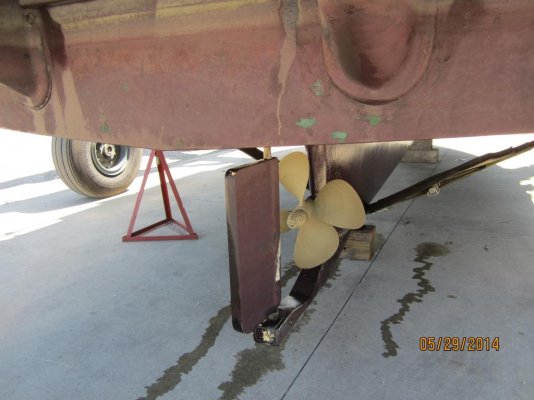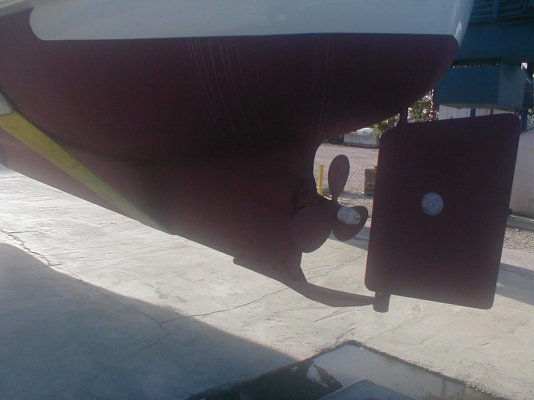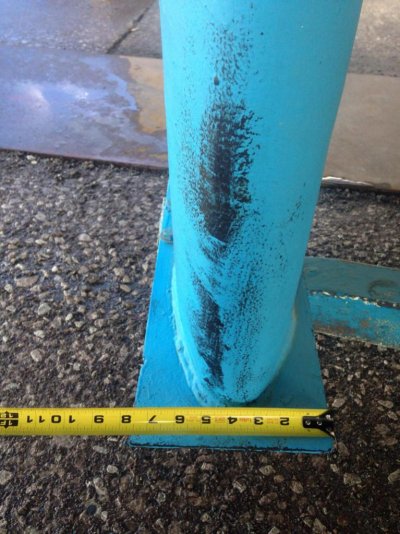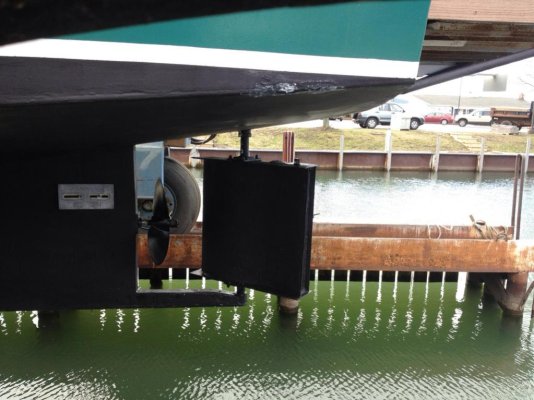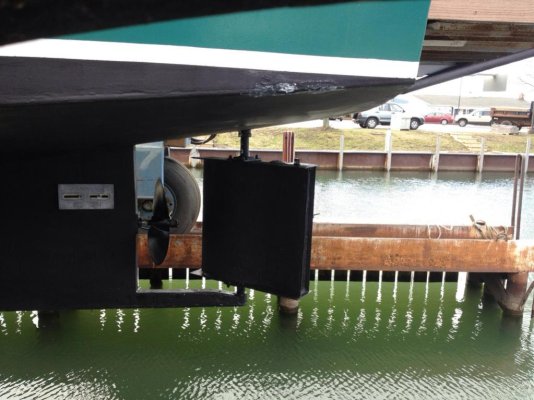You are using an out of date browser. It may not display this or other websites correctly.
You should upgrade or use an alternative browser.
You should upgrade or use an alternative browser.
A rudder to be thankful for
- Thread starter klee wyck
- Start date
The friendliest place on the web for anyone who enjoys boating.
If you have answers, please help by responding to the unanswered posts.
If you have answers, please help by responding to the unanswered posts.
Vashon_Trawler
Guru
- Joined
- Jun 13, 2013
- Messages
- 598
- Location
- USA
- Vessel Name
- M/V Sherpa
- Vessel Make
- 24' Vashon Diesel Cruiser
MurrayM
Guru
here is a video on how well a fishtail rudder can work.
ee-freaking-gad!!!!!!!
Last edited:
Correct all rudder I have a bow thruster but don't use it much except to get away from the dock.
Heck man... I've maneuvered singles (not with fish tail rudder) and not like your video reveals. My twin is really easy to play close-up with... but... it seems no better than your boat in your hands. That is you at helm, isn't it?
funangler
Senior Member
Yes that's me at the helm it's nice having a big heavy steel boat it is kind of predictable. The boat is a little harder to run with the fishtail rudder just because the size of the turn can vary so much. Most singles you go full rudder all the time for most docking turns. With the current set up I can turn rudder up to 75 degrees one way. This leads into the problem of too tight of a turn.
Last edited:
MurrayM
Guru
The backside of the fish tail is pointing way more than 90
Ahhh...and therein lies the magic

Nomad Willy
Guru
I had no idea that was possible. Very impressive and yes it would be nice if Willy did that.
However I don't think most fishtail rudders almost totally eliminate fwd movement. My rudder swings 45 degrees each way and w the big rudder we have plenty of rudder authority but w almost no drag penalty. I position my zincs above the propwash on the rudder ... not because I'm an efficiency nut but just out of principal. But I'm sure the extra drag of a fish tail rudder capable of the above performance would be noticeable. It's right in the propwash. The propwash (in concert w the rudder) effectively pushes the rudder backwards and the obvious happens as the rudder is attached to the boat. Somebody somewhere must have done a speed/efficiency loss study. The extra rudder drag can go on for 10 hours while the advantage would last only a few seconds.
But I'll weld on fishtails if the drag is low enough. But most owners may prefer bragging rights to real facts.
Seems to me the "fish tail" rudders frequently or most often have a wide rudder section in the vicinity of the rudder shaft. What role does that streamlined but fat part of the rudder play (if any) in the turning capabilities of the fish tail rudder?
There's been a lot of excitement on the Willard Boat Owners site 9in the past) about articulated rudders and that is what I'd consider a step up from the much simpler fish tail rudder. But if you can accomplish what funangler displayed in his video w the far simpler fish tail rudder why would anyone go to the extra trouble and expense to employ articulated rudders?
However if I wasn't about to launch I'd probably be cutting some flat bar.
However I don't think most fishtail rudders almost totally eliminate fwd movement. My rudder swings 45 degrees each way and w the big rudder we have plenty of rudder authority but w almost no drag penalty. I position my zincs above the propwash on the rudder ... not because I'm an efficiency nut but just out of principal. But I'm sure the extra drag of a fish tail rudder capable of the above performance would be noticeable. It's right in the propwash. The propwash (in concert w the rudder) effectively pushes the rudder backwards and the obvious happens as the rudder is attached to the boat. Somebody somewhere must have done a speed/efficiency loss study. The extra rudder drag can go on for 10 hours while the advantage would last only a few seconds.
But I'll weld on fishtails if the drag is low enough. But most owners may prefer bragging rights to real facts.
Seems to me the "fish tail" rudders frequently or most often have a wide rudder section in the vicinity of the rudder shaft. What role does that streamlined but fat part of the rudder play (if any) in the turning capabilities of the fish tail rudder?
There's been a lot of excitement on the Willard Boat Owners site 9in the past) about articulated rudders and that is what I'd consider a step up from the much simpler fish tail rudder. But if you can accomplish what funangler displayed in his video w the far simpler fish tail rudder why would anyone go to the extra trouble and expense to employ articulated rudders?
However if I wasn't about to launch I'd probably be cutting some flat bar.
funangler
Senior Member
On a sidenote I can drive this single screw more aggressively then twin screw boats. I find it a little more predictable. Twinscrew can be tricky when you get aggressive with them. Twinscrew boats will let you do some amazing maneuvers that I cannot do in a single screw.
LarryM
Guru
- Joined
- Aug 5, 2011
- Messages
- 1,069
- Location
- USA
- Vessel Name
- Pelago
- Vessel Make
- Wellcraft 3300 Coastal
"But I'm sure the extra drag of a fish tail rudder capable of the above performance would be noticeable."
"Seems to me the "fish tail" rudders frequently or most often have a wide rudder section in the vicinity of the rudder shaft. What role does that streamlined but fat part of the rudder play (if any) in the turning capabilities of the fish tail rudder?"
Eric,
If you will do a search for 'Schilling Rudder' or 'MacLear Thistle Rudder' you will find plenty of information on how and why these rudders work so well in low-speed vessels. They are popular on long-narrow canal barges and a variety of workboats and ships. My research on them leads me to believe that any increase in drag would only be noticeable above displacement speeds.
Larry
M/V Boomarang
ancora
Guru
- Joined
- Dec 16, 2007
- Messages
- 4,022
The bigger the rudder(s) the more wetted area. The more wetted area, the more drag. The more drag, the higher fuel burn. Comments?
BaltimoreLurker
Curmudgeon
- Joined
- Oct 8, 2007
- Messages
- 2,775
- Location
- USA
- Vessel Name
- Moon Dance
- Vessel Make
- 1974 34' Marine Trader Sedan
Very impressive! Damn, now another project ......
Nomad Willy
Guru
DANG,
And I thought my rudder was just fine. Next haulout. Funangler thanks for the demo ect. I would'a never believed ya w/o the video. I'll expect less w only 45 degree rudder swing and do my research.
ancora yes but the question is how much. Looks like not enough to shy away in this case. I don't think the average rudder here on TF would be capable of funangler's performance even if modified ... unless it was made MUCH larger.
Larry M,
Thanks for giving me a starting kit for my research.
I would'a thought the KK had more of a steep run of the bottom aft. Much straighter than I thought. SS rudder? How thick? My bronze rudder is 1/2". I plugged my prop hole. Will show later. Could'a just used a shapely zinc.
And I thought my rudder was just fine. Next haulout. Funangler thanks for the demo ect. I would'a never believed ya w/o the video. I'll expect less w only 45 degree rudder swing and do my research.
ancora yes but the question is how much. Looks like not enough to shy away in this case. I don't think the average rudder here on TF would be capable of funangler's performance even if modified ... unless it was made MUCH larger.
Larry M,
Thanks for giving me a starting kit for my research.
I would'a thought the KK had more of a steep run of the bottom aft. Much straighter than I thought. SS rudder? How thick? My bronze rudder is 1/2". I plugged my prop hole. Will show later. Could'a just used a shapely zinc.
markpierce
Master and Commander
- Joined
- Sep 25, 2010
- Messages
- 12,557
- Location
- USA
- Vessel Name
- Carquinez Coot
- Vessel Make
- penultimate Seahorse Marine Coot hull #6
the Coot's "barn door" makes tight turns even at idle speed.


markpierce
Master and Commander
- Joined
- Sep 25, 2010
- Messages
- 12,557
- Location
- USA
- Vessel Name
- Carquinez Coot
- Vessel Make
- penultimate Seahorse Marine Coot hull #6
The bigger the rudder(s) the more wetted area. The more wetted area, the more drag. The more drag, the higher fuel burn. Comments?
With a top speed of 7+ knots, any difference is immeasurable.
funangler
Senior Member
I built the rudder and did not change the turning cylinder size the first year. I reduce my turning radius in half overall but I wanted more. My old cylinder was 5.5 inches of travel the new one jumped to 11 inch. Where I dock have to make a tight 180 turn to get to my spot on the wall and need the zero turn ability.
While I enjoyed the video (and wished my boat had the same maneuverability), I suspect that most of that was due to the almost 90 degree rudder angle. In the view from aft you can't even see the propeller - it's entirely blanked by the rudder!
FF
Guru
- Joined
- Oct 12, 2007
- Messages
- 22,552
The usual low cost "fix" for poor low speed rudder control is 2 pieces of 1 1/2 or 2 inch angle iron the full length of the rudder trailing edge bolted to sandwich the rudder and form a T at the trailing edge.
Our prop is far more diameter than as built 32 vs 27 , and this fix was needed to easily run the locks and docks of the loop.
Our prop is far more diameter than as built 32 vs 27 , and this fix was needed to easily run the locks and docks of the loop.
Similar threads
- Replies
- 0
- Views
- 1K
- Replies
- 45
- Views
- 3K

